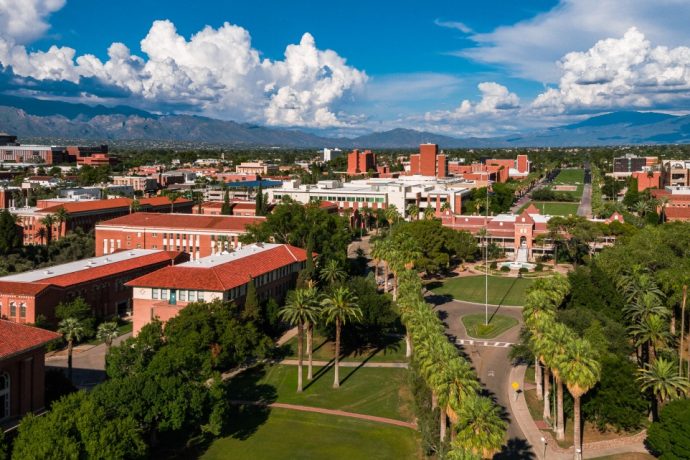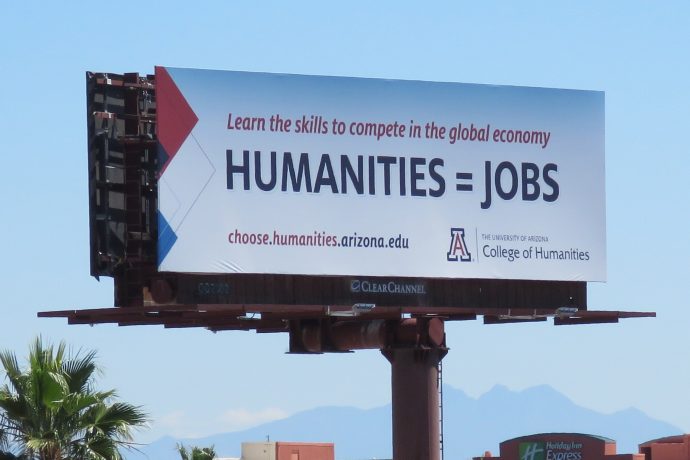- Deans have to be keen to collaborate and partner for this kind of trans-college initiative to get off the ground and be successful.
- Opportunities to make money are not always opposed to the mission of a university. Sometimes the opportunity to grow can lead to exciting intellectual innovations.
- Some students might be more willing to study the humanities if they don’t have to choose between humanistic study and pre-professional programs.
- In creating innovative curricula, consider where you are—your context, your local concerns, your students. What worked at University of Arizona (“a land grant university in the borderlands,” as Ruggill describes it) isn’t necessarily the right recipe everywhere.
- Students and parents are subjected to media stories about the widespread decline in the humanities and the inability of humanities majors to find jobs. One of the best ways to counter these narratives is to empower individual alumni in a wide range of careers to tell their stories.
University of Arizona Department of Public and Applied Humanities

In 2016, Alain-Philippe Durand succeeded Mary Wildner-Bassett as Dean of the College of Humanities at ACLS Associate Member the University of Arizona. The outgoing dean passed on an unrealized project to Durand: to create a new unit. The new dean envisioned a structure that would enable colleges to partner with each other in a way that would simultaneously benefit participating units and grow the College of Humanities. This was the genesis of Public and Applied Humanities (PAH), a department that today works with eight of the campus’s 21 colleges.
As a synthetic major, the BA in Applied Humanities is comprised of courses offered in Public and Applied Humanities and courses offered in other colleges. As the website explains, PAH is “fundamentally experimental, entrepreneurial, and transdisciplinary, and focuses on public and private opportunities that straddle rather than fall between purviews, or are confined by them.” PAH infuses humanities skills and habits of mind into pre-professional areas of study. The degree offers emphases in 11 areas including Business Administration, Environmental Systems, Fashion Studies, Game Studies, and Rural Leadership and Renewal.

In 2017, its inaugural year, PAH offered only four courses (twelve credits): a new class, Introduction to Applied Humanities; an existing course in intercultural competence; an internship; and a course borrowed from the Department of East Asian Studies, Humanities and the Global Creative Economy. The rest of the curriculum was provided by other colleges. Out of a total enrollment of 864 students in Humanities in 2017, PAH had two majors. Growth happened quickly: by fall 2023, there were 346 majors in Applied Humanities, making it the third largest unit in the college and one of the 50 largest majors on campus.
As the major grew, PAH hired new faculty, which enabled the program to offer more courses. Founding department head Judd Ruggill finds that the classes he teaches in PAH tend to be “exciting and challenging” because of the diversity of students. For example, how do you get students in business, medicine, public health, and fashion to come together on a public-facing project? He confesses that it can make for a “curious” classroom at times. But he also points out that in workplaces, it’s rare to work alongside colleagues all with the same expertise; PAH helps students grow comfortable collaborating in radically interdisciplinary settings. When partnering with a neighborhood center, for example, students can demonstrate their areas of expertise: one group of students documented the murals created by the Latinx community, another worked on models for renewing the center and potential businesses for the artists; yet another focused on public health issues and opportunities.
Ruggill has enjoyed helping create a supportive, engaged, and collaborative culture with his colleagues—an unanticipated benefit of building a department from the ground up. “Work environments matter” to faculty as well as students. The positive work culture has not only contributed to individual well-being but also to faculty productivity. Part of this is the spirit of experimentation and “becoming” that defines the unit. “The meaning of public and applied humanities continues to emerge for us,” Ruggill says.
Dean Durand believes that PAH fits into a larger vision of the humanities at the core of campus. “We’ve had a 34% increase in the number of majors in the College of Humanities since 2016,” he says. Media stories about the humanities in decline do not reflect what’s happening at UA or at many campuses, he observes. He has directed his marketing and communications teams to reach out to alumni to tell their stories, which are featured in videos on the college’s homepage and elsewhere. He shares some of their stories in a 2024 TedxUArizona talk, which sums up his philosophy: “We are putting the humanities back where they belong: at the core of the curriculum, and at the core of education.”

